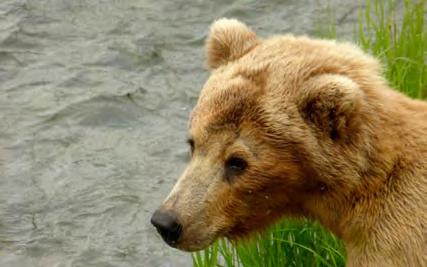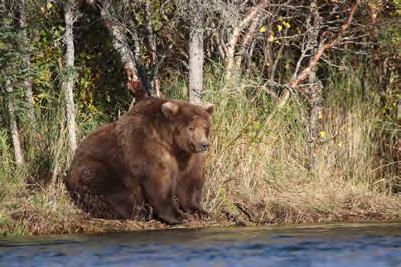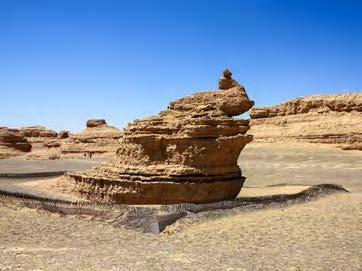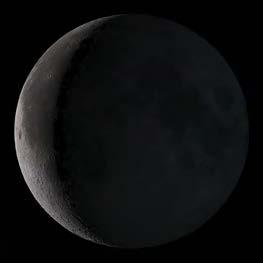Organisms in Their Environments
Observe the food web model.
Northern Great Plains Food Web
Hawk Snake Frog
Sun Sparrow Grass
Grasshopper
9. Write one number on each blank to match the role to a part of the environment.

Role Eats other living things
Source of energy for food web
Makes its own food
Part of the Environment
1. The Sun
2. Grass
3. Frog
PhD SCIENCE® TEXAS Level 4 ▸ Benchmark 2 8
© 2024 Great Minds PBC
Algae are producers that live in bodies of water.
10. Circle two statements that best describe the roles of algae in an environment.
▪ Algae get matter from the Sun.
Algae provide matter to consumers.
Algae get matter from eating other organisms.
Algae get matter from carbon dioxide and water.
Algae break down dead organisms and return matter to soil.
▪ ▪ ▪ ▪ PhD SCIENCE® TEXAS Level 4 ▸ Benchmark 2 9 © 2024 Great Minds PBC
Mangrove Forests
Mangrove trees grow in salty ocean water near shorelines. Observe the photographs and the model.


Mangrove Tree Structures
11. Circle one function of the mangrove tree’s structure that helps the tree survive in salt water.
▪ Roots trap sediment. Leaves fall into water. Seed pods float to land. Roots remove salt from water.

▪ ▪ ▪ PhD SCIENCE® TEXAS Level 4 ▸ Benchmark 2 10 © 2024 Great Minds PBC
The models show how mangrove trees can change shorelines.
Shoreline with Mangrove Trees
Shoreline Without Mangrove Trees
12. Circle two statements that describe how shorelines change when there are no mangrove trees.


▪ Erosion of sediment increases.
Erosion of sediment decreases.
Deposition of sediment increases.
Deposition of sediment decreases.
Deposition of sediment stays the same.
▪ ▪ ▪ ▪ PhD SCIENCE® TEXAS Level 4 ▸ Benchmark 2 11 © 2024 Great Minds PBC
Coral Reefs
13. The model shows how a coral reef changes waves that reach a shoreline.
Waves on a Shoreline
With a coral reef
Without a coral reef
Part A: Circle one claim the model supports.



▪ A coral reef increases the amount of energy transferred to the shoreline from waves.
▪ A coral reef decreases the amount of energy transferred to the shoreline from waves.
Part B: Use evidence from the model to support the claim you chose in Part A.
PhD SCIENCE® TEXAS Level 4 ▸ Benchmark 2 12 © 2024 Great Minds PBC
Organism Traits
The collared peccary and the prickly pear cactus live in desert environments.

Observe the photographs and read the information.
A collared peccary stands between cactuses.
A collared peccary eats a cactus stem.


A collared peccary pulls the outside layer off a cactus stem.
14. Match each collared peccary structure to its function. Use the words in the word bank to complete the table.
teeth
ears thick fur hooves
Peccary Structure Function
To pull off the outside layer of cactuses
To protect the body from sharp cactus spines
To hold the cactus leaf down while eating
PhD SCIENCE® TEXAS Level 4 ▸ Benchmark 2 13 © 2024 Great Minds PBC
Beadnose is an adult female grizzly bear that lives in Katmai National Park in Alaska. Tundra is her cub. Observe the photographs.


15. The table shows some physical traits of the bear cub. Write acquired or inherited in each row to complete the table.
Physical Trait
Tundra has two ears.
Tundra has brown fur.
Tundra has a scar above her eye.
Acquired or Inherited
Beadnose Tundra
PhD SCIENCE® TEXAS Level 4 ▸ Benchmark 2 14 © 2024 Great Minds PBC
Level 4 Benchmark 2 Rubric
Score each student’s Benchmark. The rubric describes evidence of student work that meets expectations. Use the Score column to record the student’s points for each item.
2 4.3A 4.5G 4.10B
Choice 1 is correct.
Choice 2 is incorrect. Earthquake cracks form quickly, and yardangs form slowly. Choice 3 is incorrect. Earthquake cracks form quickly, and yardangs form slowly.
Choice 4 is incorrect. Yardangs are caused by changes to the surface of the Mojave Desert. Choice 5 is correct.
Choice 1 is correct.
Choice 2 is incorrect. Ice, not wind, weathered the rock.
Choice 3 is incorrect. Pressure did not erode the land. Ice weathered the mountain, and gravity eroded the weathered rock.
Choice 4 is incorrect. Ice, not pressure, weathered the rock.
Choice 1 is incorrect. Temperature does not cause materials to sink in water. Choice 2 is incorrect. Magnetism does not cause materials to sink in water.
Choice 3 is correct.
Choice 4 is incorrect. Physical state does not cause materials to sink in water.
PhD SCIENCE® TEXAS
Name: Date: Item TEKS Assessed Answer Key Item Points Score
4.1E 4.5C 3.10C 4.10B
1
2
1 3 4.1G 4.5B 4.10B Line 1: 3 Line 2: 2 Line 3: 1 2 4 4.5A
4.6A
1 5 4.1G 4.5E 4.10A Line 1: 2 Line 2: 1 Line 3: 3 2 Level 4 ▸ Benchmark 2 1 © 2024 Great Minds PBC
12 4.3A 4.5B 4.10B
Choice 1 is incorrect. Temperature does not affect the rate of deposition in the lake. Choice 2 is correct.
Choice 3 is incorrect. Warmer temperature increases evaporation from the lake, which reduces water volume.
Choice 4 is incorrect. Warmer temperature increases evaporation from the lake, which reduces water volume.
Choice 1 is incorrect. Producers get energy, not matter, from the Sun. Choice 2 is correct.
Choice 3 is incorrect. Algae are producers and do not eat organisms to get matter. Choice 4 is correct.
Choice 5 is incorrect. Algae are not decomposers.
Choice 1 is incorrect. Trapping sediment does not help mangrove trees survive in salt water. Choice 2 is incorrect. Leaves falling into water does not help mangrove trees survive in salt water.
Choice 3 is incorrect. Seed pods floating to land does not help mangrove trees survive in salt water.
Choice 4 is correct.
Choice 1 is correct.
Choice 2 is incorrect. Erosion of sediment increases on shorelines without mangrove trees.
Choice 3 is incorrect. Deposition of sediment decreases on shorelines without mangrove trees. Choice 4 is correct.
Choice 5 is incorrect. Deposition of sediment decreases on shorelines without mangrove trees.
Item TEKS Assessed Answer Key Item PointsScore 6 4.1G 4.5B 4.10A Line
Line
Line
2
4.3A 4.5B 4.10A
1: precipitation
2: evaporation
3: condensation
7
1 8 4.2B 4.10C Row 1: Weather Row 2: Climate Row 3: Climate 2 9 4.1G 4.5E 4.12A 4.12B Line 1: 3 Line 2: 1 Line 3: 2 2
4.5E 4.12A
10
4.12B
2
11 4.1E 4.5F 4.13A
1
2 PhD SCIENCE® TEXAS Level 4 ▸ Benchmark 2 2 © 2024 Great Minds PBC
13A
Choice 1 is incorrect. The models show that the amount of energy transferred by waves decreases when a coral reef is present. Choice 2 is correct.
2 points: The student identifies that (1) the wave height in the model with a coral reef is less than the wave height in the model without a coral reef, and (2) the presence of a coral reef reduces the amount of energy transferred to the shoreline.
1 point: The student identifies one of the two criteria required for 2 points.
16A
Choice 1 is correct.
Choice 2 is incorrect. The photograph shows a sample of Oobleck that behaves like a solid.
16B
2 points: The student identifies (1) the properties of Oobleck in Photograph 1 that are like those of a liquid, such as evidence of pouring, a fixed volume, or that Oobleck takes the shape of its container, and (2) the properties of Oobleck in Photograph 2 that are like those of a solid, such as having a fixed shape or that pushes and pulls can change the shape.
1 point: The student identifies one of the two criteria required for 2 points.
17
Choice 1 is incorrect. When there is no sound, Oobleck will not move. Choice 2 is incorrect. When there is no sound, Oobleck will not move. Choice 3 is correct.
Choice 1 is incorrect. The color of the wagon does not provide data about the wagon’s motion. Choice 2 is incorrect. The mass of the wagon is constant and does not affect the investigation.
Choice 3 is correct.
Choice 4 is incorrect. The temperature of the wagon does not provide data about the wagon’s motion.
Choice 5 is correct.
Item TEKS Assessed
Answer Key Item PointsScore
4.5B 4.8A
1
4.3A 4.5E 4.8A
13B
2
4.3A 4.5F 3.13A Row
Row
Row
2
4.3A 4.5A 4.13B Row
Row
Row
2
14
1: teeth
2: thick fur
3: hooves
15
1: inherited
2: inherited
3: acquired
4.1E 4.6A
1
4.3A 4.5A 4.6A
2
4.1G 4.5B 4.8A
1
4.1B 4.5B 3.7B
18
1 PhD SCIENCE® TEXAS Level 4 ▸ Benchmark 2 3 © 2024 Great Minds PBC
20 4.2B 3.6D
Choice 1 is incorrect. The seat’s color does not provide data about the seat’s location.
Choice 2 is incorrect. The seat’s speed provides data about the seat’s motion, not its location. Choice 3 is incorrect. The seat’s shape does not provide data about the seat’s location. Choice 4 is correct.
Choice 1 is incorrect. Felt does not float.
Choice 2 is correct.
Choice 3 is incorrect. Stone does not float. Choice 4 is incorrect. Metal does not float. Choice 5 is correct.
21 4.2B 4.5A 4.9B
Choice 1 is incorrect. Less of the Moon will be visible on February 20, 2039, with only a small crescent visible on the left side.

Choice 2 is incorrect. Less of the Moon will be visible on February 20, 2039, with only a small crescent visible on the left side.
Choice 3 is correct.
Choice 4 is incorrect. Less of the Moon will be visible on February 20, 2039, with only a small crescent visible on the left side.
22 4.2B
4.5A
4.9A
Choice 1 is incorrect. Average day length in winter will be shorter than average day length in fall. Choice 2 is correct.
Choice 3 is incorrect. Average day length in winter will be shorter than average day length in spring.
Choice 4 is correct.
Choice 5 is incorrect. Average day length in winter will be shorter than average day length in summer.
23
4.2B 4.5A 4.9A
Choice 1 is correct.
Choice 2 is incorrect. Summer will have a longer average day length than fall. Choice 3 is incorrect. Winter will have the shortest average day length. Choice 4 is incorrect. Summer will have a longer average day length than spring.
1
Total Points 39
Item TEKS Assessed
Item PointsScore
Answer Key
19 4.1B 4.5B 3.7B
1
2
1
2
Score PhD SCIENCE® TEXAS Level 4 ▸ Benchmark 2 4 © 2024 Great Minds PBC
Benchmark 2 Alignment Map
For teacher reference, this alignment map lists the Texas Essential Knowledge and Skills assessed by each item in the Benchmark.
1 The student uses observations (4.1E) to compare (4.5C) rapid changes to Earth’s surface caused by earthquakes (3.10C) and slow changes to Earth’s surface caused by weathering and erosion by wind (4.10B).
3.10C Model and describe rapid changes in Earth’s surface such as volcanic eruptions, earthquakes, and landslides.
4.10B Model and describe slow changes to Earth’s surface caused by weathering, erosion, and deposition from water, wind, and ice.
2 The student uses the model to explain (4.3A) that weathering caused by ice (4.5G) changed the shape of the landform (4.10B).
4.10B Model and describe slow changes to Earth’s surface caused by weathering, erosion, and deposition from water, wind, and ice.
3 The student uses the model (4.1G) to identify weathering, erosion, and deposition from water (4.10B) as processes that cause minerals to accumulate in Spotted Lake (4.5B).
4 The student uses the location of minerals in Spotted Lake (4.5A) to classify matter by relative density (4.6A).
4.10B Model and describe slow changes to Earth’s surface caused by weathering, erosion, and deposition from water, wind, and ice.
4.1E Collect observations and measurements as evidence.
4.5C Use scale, proportion, and quantity to describe, compare, or model different systems.
▪ 4.6A Classify and describe matter using observable physical properties, including temperature, mass, magnetism, relative density (the ability to sink or float in water), and physical state (solid, liquid, gas).
4.3A Develop explanations and propose solutions supported by data and models.
4.5G Explain how factors or conditions impact stability and change in objects, organisms, and systems.
4.1G Develop and use models to represent phenomena, objects, and processes or design a prototype for a solution to a problem.
N/A
4.5B Identify and investigate cause-and-effect relationships to explain scientific phenomena or analyze problems.
▪ 4.5A Identify and use patterns to explain scientific phenomena or to design solutions.
Item
Integration of Standards Content Standards Scientific and Engineering Practices Recurring Themes and Concepts
▪ ▪ ▪ ▪
▪ ▪ ▪
▪ ▪ ▪
PhD SCIENCE® TEXAS Level 4 ▸ Benchmark 2 5 © 2024 Great Minds PBC
ItemIntegration
5 The student uses the model (4.1G) of the movement of water at Spotted Lake (4.5E) to describe the processes occurring during the water cycle (4.10A).
6 The student uses the model (4.1G) to predict how processes during the water cycle (4.10A) cause changes in the water level of Spotted Lake (4.5B).
4.10A Describe and illustrate the continuous movement of water above and on the surface of the Earth through the water cycle and explain the role of the Sun as a major source of energy in this process.
4.10A Describe and illustrate the continuous movement of water above and on the surface of the Earth through the water cycle and explain the role of the Sun as a major source of energy in this process.
4.1G Develop and use models to represent phenomena, objects, and processes or design a prototype for a solution to a problem.
4.5E Investigate how energy flows and matter cycles through systems and how matter is conserved.
7 The student uses data to explain (4.3A) how changes in temperature cause the water volume of Spotted Lake to change (4.5B) through the cycling of water (4.10A).
8 The student analyzes conditions of Spotted Lake (4.2B) to differentiate between weather and climate (4.10C).
9 The student uses the model (4.1G) to determine the roles of the Sun, grass, and frog (4.12A, 4.12B) in the environment (4.5E).
4.10A Describe and illustrate the continuous movement of water above and on the surface of the Earth through the water cycle and explain the role of the Sun as a major source of energy in this process.
4.1G Develop and use models to represent phenomena, objects, and processes or design a prototype for a solution to a problem.
4.5B Identify and investigate cause-and-effect relationships to explain scientific phenomena or analyze problems.
▪
4.10C Differentiate between weather and climate.
4.3A Develop explanations and propose solutions supported by data and models.
4.5B Identify and investigate cause-and-effect relationships to explain scientific phenomena or analyze problems.
4.2B Analyze data by identifying any significant features, patterns, or sources of error.
4.12A Investigate and explain how most producers can make their own food using sunlight, water, and carbon dioxide through the cycling of matter.
4.12B Describe the cycling of matter and flow of energy through food webs, including the roles of the Sun, producers, consumers, and decomposers.
4.1G Develop and use models to represent phenomena, objects, and processes or design a prototype for a solution to a problem.
4.5E Investigate how energy flows and matter cycles through systems and how matter is conserved.
of Standards Content Standards Scientific and Engineering Practices Recurring Themes and Concepts
▪ ▪ ▪
▪ ▪ ▪
▪ ▪ ▪
▪
N/A
▪ ▪ ▪ ▪
PhD SCIENCE® TEXAS Level 4 ▸ Benchmark 2 6 © 2024 Great Minds PBC
10 The student explains how matter cycles in an environment (4.5E) by describing how algae use carbon dioxide and water to get matter (4.12A) and provide matter to consumers (4.12B).
▪ ▪
4.12A Investigate and explain how most producers can make their own food using sunlight, water, and carbon dioxide through the cycling of matter.
4.12B Describe the cycling of matter and flow of energy through food webs, including the roles of the Sun, producers, consumers, and decomposers.
N/A
▪ 4.5E Investigate how energy flows and matter cycles through systems and how matter is conserved.
11 The student uses observations as evidence (4.1E) to identify that the roots of the mangrove tree (4.5F) allow it to survive in salt water (4.13A).
12 The student uses evidence to explain (4.3A) that erosion by water increases and deposition by water decreases near shorelines (4.10B) without mangrove tree forests (4.5B).
13A The student identifies that the coral reef decreases (4.5B) the transfer of energy from waves (4.8A).
13B The student uses evidence from the model to explain (4.3A) that a coral reef decreases the amount of energy (4.5E) transferred by waves to the shoreline (4.8A).
4.13A Explore and explain how structures and functions of plants such as waxy leaves and deep roots enable them to survive in their environment.
4.10B Model and describe slow changes to Earth’s surface caused by weathering, erosion, and deposition from water, wind, and ice.
▪ 4.8A Investigate and identify the transfer of energy by objects in motion, waves in water, and sound.
▪
4.8A Investigate and identify the transfer of energy by objects in motion, waves in water, and sound.
4.1E Collect observations and measurements as evidence.
4.5F Explain the relationship between the structure and function of objects, organisms, and systems.
4.3A Develop explanations and propose solutions supported by data and models.
N/A
▪
4.5B Identify and investigate cause-and-effect relationships to explain scientific phenomena or analyze problems.
4.3A Develop explanations and propose solutions supported by data and models.
4.5B Identify and investigate cause-and-effect relationships to explain scientific phenomena or analyze problems.
4.5E Investigate how energy flows and matter cycles through systems and how matter is conserved.
of Standards Content Standards Scientific and Engineering Practices Recurring Themes and Concepts
ItemIntegration
▪ ▪ ▪
▪ ▪
▪
▪ ▪
PhD SCIENCE® TEXAS Level 4 ▸ Benchmark 2 7 © 2024 Great Minds PBC
14 The student uses data to explain (4.3A) collared peccary structures and functions (4.5F) that help the collared peccary survive in its environment (3.13A).
15 The student identifies patterns (4.5A) in the physical appearance of a mother bear and her cub to differentiate (4.3A) between inherited and acquired physical traits (4.13B).
16A The student uses observations of Oobleck as evidence (4.1E) to classify Oobleck by its physical state (4.6A).
3.13A Explore and explain how external structures and functions of animals such as the neck of a giraffe or webbed feet on a duck enable them to survive in their environment.
4.13B Differentiate between inherited and acquired physical traits of organisms.
4.3A Develop explanations and propose solutions supported by data and models.
4.5F Explain the relationship between the structure and function of objects, organisms, and systems.
4.3A Develop explanations and propose solutions supported by data and models.
4.5A Identify and use patterns to explain scientific phenomena or to design solutions.
16B The student uses patterns of states of matter (4.5A) to explain (4.3A) that in Photograph 1 Oobleck behaves like a liquid (4.6A).
4.6A Classify and describe matter using observable physical properties, including temperature, mass, magnetism, relative density (the ability to sink or float in water), and physical state (solid, liquid, gas).
4.6A Classify and describe matter using observable physical properties, including temperature, mass, magnetism, relative density (the ability to sink or float in water), and physical state (solid, liquid, gas).
4.1E Collect observations and measurements as evidence. N/A
4.3A Develop explanations and propose solutions supported by data and models.
4.5A Identify and use patterns to explain scientific phenomena or to design solutions.
ItemIntegration of Standards Content Standards Scientific and Engineering Practices Recurring Themes and Concepts
▪ ▪ ▪
▪ ▪ ▪
▪ ▪
▪ ▪ ▪
PhD SCIENCE® TEXAS Level 4 ▸ Benchmark 2 8 © 2024 Great Minds PBC
ItemIntegration of Standards Content Standards
17 The student uses a model of Oobleck movement on a speaker (4.1G) to choose the claim that there will be no transfer of energy (4.8A) in the system when there is no sound produced by the speaker (4.5B).
18 The student identifies time and distance as data (4.1B) needed to investigate how a pull causes (4.5B) the motion of a wagon to change (3.7B).
4.8A Investigate and identify the transfer of energy by objects in motion, waves in water, and sound.
Scientific and Engineering Practices Recurring Themes and Concepts
4.1G Develop and use models to represent phenomena, objects, and processes or design a prototype for a solution to a problem.
4.5B Identify and investigate cause-and-effect relationships to explain scientific phenomena or analyze problems.
19 The student decides to collect data (4.1B) on the height of the seat to investigate how a push causes (4.5B) the seat’s location to change (3.7B).
3.7B Plan and conduct a descriptive investigation to demonstrate and explain how position and motion can be changed by pushing and pulling objects such as swings, balls, and wagons.
3.7B Plan and conduct a descriptive investigation to demonstrate and explain how position and motion can be changed by pushing and pulling objects such as swings, balls, and wagons.
20 The student analyzes the table and identifies plastic foam and wood as possible materials for creating a life jacket because the materials float (3.6D, 4.2B).
3.6D Demonstrate that materials can be combined based on their physical properties to create or modify objects such as building a tower or adding clay to sand to make a stronger brick and justify the selection of materials based on their physical properties.
4.1B Use scientific practices to plan and conduct descriptive investigations and use engineering practices to design solutions to problems.
4.5B Identify and investigate cause-and-effect relationships to explain scientific phenomena or analyze problems.
4.1B Use scientific practices to plan and conduct descriptive investigations and use engineering practices to design solutions to problems.
4.5B Identify and investigate cause-and-effect relationships to explain scientific phenomena or analyze problems.
4.2B Analyze data by identifying any significant features, patterns, or sources of error.
▪ ▪ ▪
▪ ▪ ▪
▪ ▪ ▪
▪ ▪
N/A PhD SCIENCE® TEXAS Level 4 ▸ Benchmark 2 9 © 2024 Great Minds PBC
ItemIntegration of Standards Content Standards
21 The student identifies patterns (4.5A) in data (4.2B) to predict the appearance of the Moon from Earth on February 20, 2039 (4.9B).
22 The student identifies patterns (4.5A) in the average day length data (4.2B) and predicts that winter will have shorter average day lengths than fall and spring (4.9A).
23 The student analyzes the day length data (4.2B) to identify patterns (4.5A) and predict that summer will have the longest average day length (4.9A).
▪
Scientific and Engineering Practices Recurring Themes and Concepts
▪
4.9B Collect and analyze data to identify sequences and predict patterns of change in the observable appearance of the Moon from Earth.
4.9A Collect and analyze data to identify sequences and predict patterns of change in seasons such as change in temperature and length of daylight.
4.9A Collect and analyze data to identify sequences and predict patterns of change in seasons such as change in temperature and length of daylight.
4.2B Analyze data by identifying any significant features, patterns, or sources of error.
4.5A Identify and use patterns to explain scientific phenomena or to design solutions.
4.2B Analyze data by identifying any significant features, patterns, or sources of error.
4.5A Identify and use patterns to explain scientific phenomena or to design solutions.
4.2B Analyze data by identifying any significant features, patterns, or sources of error.
4.5A Identify and use patterns to explain scientific phenomena or to design solutions.
▪ ▪
▪ ▪
▪ ▪ ▪
PhD SCIENCE® TEXAS Level 4 ▸ Benchmark 2 10 © 2024 Great Minds PBC



 Earthquake crack Yardang
Earthquake crack Yardang






















